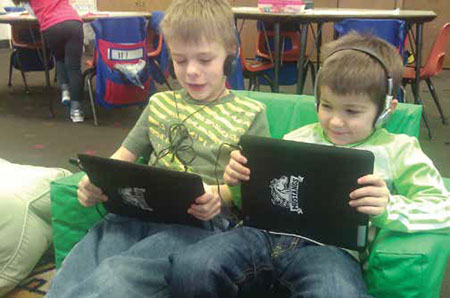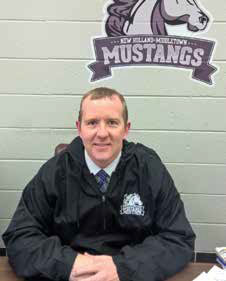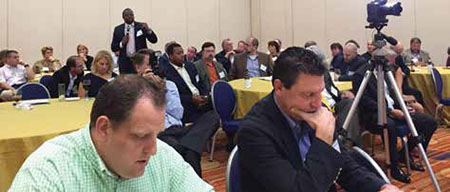BRINGING 21ST CENTURY SKILLS TO A RURAL DISTRICT

Overcoming barriers to student achievement is a mission with which all schools have been charged, whether those barriers are lack of financial resources, access to quality curricular offerings, available technology, or a remote rural location. For decades, educators and politicians alike have been advocating for an educational system in which “no child is left behind.” But despite best efforts, inequities persist in remote, rural, and poor communities. Below is an account of how one district overcame their digital inequity.
SETTING
Although New Holland-Middletown Elementary District #88 in Illinois is a high poverty area, efforts by the local community ensure all kids are connected. Located in Logan County in central Illinois, this 72-square-mile district encompasses two small villages and a large, unincorporated area. 120 students attend the district’s K-8 school in Middletown.

Although it’s a high-poverty area with limited resources, a look inside the school reveals students actively using the latest technology. Not only has this rural district managed to obtain broadband Internet, each student has a dedicated device with ubiquitous online access. Students use these devices daily and work with various operating systems (Apple, Google, and Microsoft) in rigorous and engaging blended learning environments. “Makerspaces” and piloting drones are two examples of students engaged in current STEM technology.
Pre-K-grade 2 students use Apple iPads, while intermediate students (grades 3-6) access the cloud with Google Drive, Google Classroom, and Chromebooks. Junior high students (grades 7-8) use laptops and Microsoft Surface devices to collaborate with each other and their teachers via blogging and online learning modules in the Windows 10/Office 365 environment.
A new dedicated “makerspace” was recently funded by a STEM grant that supports design thinking, creating, and tinkering. This centrally located public makerspace, the only one in central Illinois, is being outfitted with MacBooks, interactive displays, 3D printers, and design and construction materials. All of this technology helps level the digital playing field for the students, who had previously been at a disadvantage due to this rural location.
STEPS
Tools and ideas to transform education. Sign up below.
Moving from a district equipped with minimal technology to one of innovation was not a simple process. Many large districts with similar levels of poverty have benefitted from philanthropic measures from such companies as Comcast and Sprint through their contributions to districts’ technology efforts. In small rural schools, it is more difficult to obtain such endowments – particularly for only 120 students.

Four years ago, the hard-working people of New Holland and Middletown, Illinois, “rolled up their sleeves” and formed volunteer groups to work together toward ensuring every child left the district as prepared for college and career as any student anywhere.
Through a combination of corporate grants (Lowe’s and Monsanto), social media contests (State Farm/Facebook Neighborhood Assist), and community fund-raising functions (Family Fun Days and celebrity bartender appearances), these two communities worked together to provide much needed modern technology for their students.

This self-reliant community approach to supporting district technology needs put New Holland-Middletown ESD #88 on the map. Instead of being defeated by digital inequity and other disadvantages, the community worked together to provide its students with the tools they need to become college and career-ready.
Todd Dugan is the Superintendent of New Holland-Middletown Elementary District #88 in Illinois. The district has won many awards including inclusion in the White House’s annual “Nation of Makers” recognition. Dugan lives in rural, central Illinois and is currently finishing his doctoral research at Illinois State University, a qualitative case study of high-poverty schools in Illinois, titled “Inadequacy, Inequity and Injustice in Illinois Schools.”
SCHOOLCIO SUMMIT TAKEAWAYS
During the closing session of the SchoolCIO Summit, attendees reflected on their discussions to create a list of takeaways they would bring back to their districts. Here are some highlights:
■ No matter the size of our districts, we are all facing similar issues. I plan to explore the resources shared at Summit, including ConnectEd, ConnectHome, Future Ready, and Common Sense Media School certifications.

■ We should get teachers out of their grade levels and buildings to see what is going on outside their typical environment to see the different ways kids interact and learn differently.
■ School leaders need to lobby E-Rate for changes to the current fund distribution method.
■ School leaders should make better connections with their community organizations, especially Section 8 housing officers, about the needs of local families. Other community resources that could be better utilized include the public library, local businesses, local property management firms, and the YMCA
■ Schools should collaborate with other districts in the same area to compare broadband costs and have bargaining power with local providers who may be charging other districts less.
■ Schools should spend more time researching best practices to connect teachers and students with others who have successful digital equity, innovative learning spaces, and PD programs.
■ Schools should partner with their ISPs in addition to contacting Verizon, Comcast, and AT&T to explore opportunities for high-speed Internet for the home.
DIGITAL EQUITY RESOURCES
What follows are additional resources schools can utilize for digital equity:
CoSN: Digital Equity Toolkit: http://www.cosn.org/focus-areas/leadership-vision/digital-equity-action-agenda
Everyone On: http://everyoneon.org/ (to find low-cost Internet and devices in your area)
ESSA and School Libraries: http://essa.aasl.org/
Future Ready Hub: http://futurereadyschools.org/framework/technology-networks-and-hardware/
Future Ready Librarians: http://futureready.org/about-the-effort/librarians/
National Ed Tech Plan 2016: tech.ed.gov/netp
SETDA’S Broadband Imperative II: http://www.setda.org/priorities/equity-of-access/broadband-imperativeii-2016/
Todd Dugan is the Superintendent of Bunker Hill CUSD #8 located in Bunker Hill, Illinois -- a rural district in downstate Illinois. Most recently, Dugan was awarded the 2019 winner of American Association of School Administrators’ (AASA) “Leaders Matter” campaign.
